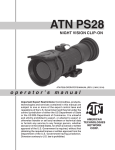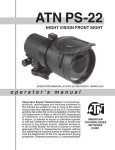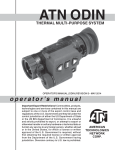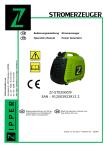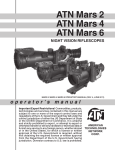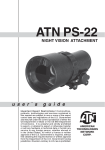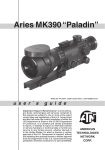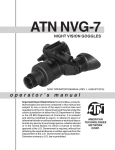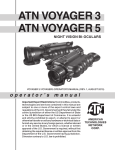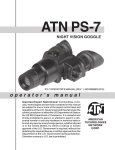Download ATN PS-40/ATN PS-40 MGC operator`s manual
Transcript
ATN PS-40 ATN PS-40 MGC NIGHT VISION FRONT SIGHTS ATN PS-40/ ATN PS-40 MGC operator’s manual (Rev. 3, august 2010) operator’s manual Important Export Restrictions! Commodities, products, technologies and services contained in this manual are subject to one or more of the export control laws and regulations of the U.S. Government and they fall under the control jurisdiction of either the US Department of State or the US BIS-Department of Commerce. It is unlawful and strictly prohibited to export, or attempt to export or otherwise transfer or sell any hardware or technical data or furnish any service to any foreign person, whether abroad or in the United States, for which a license or written approval of the U.S. Government is required, without first obtaining the required license or written approval from the Department of the U.S. Government having jurisdiction. Diversion contrary to U.S. law is prohibited. Register your product warranty online at www.atncorp.com/warranty The information in this manual is furnished for information use only, is subject to change without notice, cannot be construed as a commitment by ATN Corp. ATN Corp. assumes no responsibility or liability for any errors or inaccuracies that may appear in this book. © 2010 ATN Corp. All right reserved. SAFETY SUMMARY STUDY CAREFULLY THIS MANUAL BEFORE TURNING ON AND OPERATING THIS PRODUCT. CAUTIONS The ATN PS-40 night vision unit is a precision electron-optical instrument and requires careful handling. To provide safe use of the sight the following instructions should be observed: •Do not dismantle the unit. •Keep the unit clean; protect it from moisture, sharp temperature drops and shocks. •Be careful not to touch the glass surfaces. If you put fingerprints on, or contaminate the glass surfaces, use only clean and soft materials to clean it. •Protect the unit from excessive lighting. Do not turn the sight on in daylight with the front lens cap off. Do not point the sight at the bright light source (a fire, car headlights, lanterns, street lamps, room lights, etc.). • Do not test the device in daylight conditions even with the daylight filter/lens cap on for more than ten (10) minutes. •Do not leave the unit in on position during stops in operation. •Remove the battery from the unit when storing for periods exceeding 3 days. Failure to do so may damage unit. C aution: This product contains natural rubber latex which may cause allergic reactions. a Equipment Limitations To avoid physical and equipment damage when using the ATN PS-40, carefully read and understand the following equipment limitations. • The equipment requires some night light (moonlight, starlight, etc.) to operate. The level of equipment performance depends upon the level of light. • Night light reduces by passing through the clouds, while operating under trees, at building shadows, etc. • The equipment is less effective when viewing into shadows and other darkened areas. • The equipment is less effective when viewing through the rain, fog, sleet, snow or smoke. • The equipment will not “see” through the dense smoke. b TABLE OF CONTENTS pg. SAFETY SUMMARY a SECTION I. INTRODUCTION 1.1. General 1.1.1. Scope 1.1.2.Reports 1.1.3. Storage 1.1.4. Warranty 1.2. Description and Data 1.2.1. Description 1.2.2.PS-40 Standard Components and Optional Equipment 1-1 1-2 1-2 1-2 1-2 1-3 1-5 1-5 SECTION II. OPERATING INSTRUCTIONS 2.1. Installation Procedures 2.1.1. Battery Installation 2.1.2. Installation on MIL-STD-1913 Rail 2.1.3. Installation on Dayscope Objective Lens 2.2.Operating Procedures 2.2.1. General 2.2.2.Controls and Indicators 2.2.3.Operating Procedures 2.2.4. Operating at Changing Light Condition 2.2.5. Gain Control 2.2.6.Stowage of PS-40 2.3.Installation and Use of Accessories 2.3.1. 7/8” Weaver Mount 2.3.2 Adapter for A.R.M.S. Mounts 2.3.3.Remote Control 2.3.4.Platform Ring 2.3.5.Long Rail Adapter 2.3.6. B.A.M. System 2.3.7. IR450 Illuminator 2-1 2-2 2-2 2-3 2-4 2-7 2-7 2-7 2-8 2-10 2-10 2-11 2-12 2-12 2-13 2-13 2-14 2-15 2-15 2-17 1-8 i 2.3.8. Day Scope Light Suppressor 2.3.9. Extended Focus Knob SECTION III. OPERATIONAL DEFECTS 3.1. Zeroing Operational Defects 3.1.1. Shading 3.1.2.Edge Glow 3.1.3. Flashing, Flickering, or Intermittent Operation 3.1.4. Cosmetic Blemishes 2-18 2-19 3-1 3-2 3-2 3-3 3-3 3-3 SECTION IV. MAINTENANCE INSTRUCTIONS 4-1 4.1. Preventive Maintenance Checks and Services (PMCS) 4-2 4.1.1. Purpose of PMCS 4-2 4.1.2. PMCS Procedures 4-2 4.2. Troubleshooting 4-6 4.2.1. General 4-6 4.2.2.Troubleshooting Procedures 4-6 4.3. Maintenance Procedures 4-9 4.3.1. Scope of PS-40 Maintenance 4-9 4.3.2.Cleaning Procedures 4-9 Appendix A. Spare Parts List A-1 Appendix B. How to select Scope Mounting System B-1 Appendix C. Estimation of Ambient Illumination Level C-1 Appendix D. Night Vision Front Sights Image Intensifier Tube Replacement Manual D-1 ii SECTION I introduction 1-1 1.1 General Information 1.1.1. Scope This manual contains instructions for use in operating and maintaining the ATN PS-40 and PS-40 MGC Night Vision Front Sights. Throughout this manual, the ATN PS-40 and PS-40 MGC will be referred to as the sights or the PS-40. 1.1.2. Reports Reports from the user on recommendations for improvements are encouraged. Send reports to the address below. American Technologies Network Corp. 1341 San Mateo Avenue South San Francisco, CA 94080 (800) 910-2862 (650) 989-5100 (650) 875-0129 fax www.atncorp.com [email protected] 1.1.3. Storage Storage of the PS-40 should be done in the factory packing and after a thorough PMCS as outlined in Section IV of this manual. This will ensure the sight remains in mission ready condition during storage. Battery should be stored separately from the sight. The PS-40 should not be placed on the floor, in any area exposed to high temperatures or direct sunlight. Presence of acid and alkaline vapor, as well as of other aggressive admixtures in the air is unacceptable. 1-2 1.1.4.Warranty 2 Year Product Warranty This product is guaranteed to be free from manufacturing defects in material and workmanship under normal use for a period of 2 (two) years from the date of purchase. In the event a defect that is covered by the foregoing warranty occurs during the applicable period stated above, ATN, at its option, will either repair or replace the product, and such action on the part of ATN shall be the full extent of ATN’s liability, and the Customer’s sole and exclusive remedy. This warranty does not cover a product (a) used in other than its normal and customary manner; (b) subjected to misuse; (c) subjected to alterations, modifications or repairs by the Customer of by any party other than ATN without prior written consent of ATN; (d) special order or “close-out” merchandise or merchandise sold “as-is” by either ATN or the ATN dealer; or (e) merchandise that has been discontinued by the manufacturer and either parts or replacement units are not available due to reasons beyond the control of ATN. ATN shall not be responsible for any defects or damage that in ATN’s opinion is a result from the mishandling, abuse, misuse, improper storage or improper operation, including use in conjunction with equipment which is electrically or mechanically incompatible with or of inferior quality to the product, as well as failure to maintain the environmental conditions specified by the manufacturer. CUSTOMER IS HEREBY NOTIFIED THAT OPERATION OF THE EQUIPMENT DURING DAYLIGHT HOURS OR UNDER ANY EXCESSIVE LIGHT CONDITIONS MAY PERMANENTLY DAMAGE THE INTERNAL COMPONENTS OF THE UNIT AND SAID DAMAGE WILL NOT BE COVERED UNDER THIS WARRANTY. This warranty is extended only to the original purchaser. Any breach of this warranty shall be waived unless the customer notifies ATN at the address noted below within the applicable warranty period. The customer understands and agrees that except for the foregoing warranty, no other warranties written or oral, statutory, expressed or implied, including any implied warranty of merchantability or fitness for a particular purpose, shall apply to the product. All such implied warranties are hereby and expressly disclaimed. Limitation of Liability ATN will not be liable for any claims, actions, suits, proceedings, costs, expenses, damages or liabilities arising out of the use of this product. Operation and use of the product are the sole responsibility of the Customer. ATN’s sole undertaking is limited to providing the products and services outlined herein in accordance with the terms and conditions of this Agreement. The provision of products sold and services performed by ATN to the Customer shall not be interpreted, construed, or regarded, either expressly or implied, as being for the benefit of or creating 1-3 any obligation toward any third party of legal entity outside ATN and the Customer; ATN’s obligations under this Agreement extend solely to the Customer. ATN’s liability hereunder for damages, regardless of the form or action, shall not exceed the fees or other charges paid to ATN by the customer or customer’s dealer. ATN shall not, in any event, be liable for special, indirect, incidental, or consequential damages, including, but not limited to, lost income, lost revenue, or lost profit, whether such damages were foreseeable or not at the time of purchase, and whether or not such damages arise out of a breach of warranty, a breach of agreement, negligence, strict liability or any other theory of liability. Product Warranty Registration In order to validate the warranty on your product, ATN must receive a completed Product Warranty Registration Card for each unit or complete warranty registration on our website at www.atncorp.com. Please complete the included form and immediately mail it to our Service Center: ATN Corporation, 1341 San Mateo Avenue, South San Francisco, CA 94080. Obtaining Warranty Service To obtain warranty service on your unit, End-user must notify ATN service department by calling 800-910-2862 or 650-989-5100 or via e-mail [email protected] to receive a Return Merchandise Authorization number (RMA). When returning please take or send the product, postage paid, with a copy of your sales receipt to our service center, ATN Corporation at the address noted above. All merchandise must be fully insured with the correct postage; ATN will not be responsible for improper postage or, missing or damaged merchandise during shipment. When sending product back, please clearly mark the RMA# on the outside of the shipping box. Please include a letter that indicates your RMA#, Name, Return Address, reason for service return, Contact information such as valid telephone numbers and/or e-mail address and proof of purchases that will help us to establish the valid start date of the warranty. Product merchandise returns that do not have an RMA listed may be refused or a significant delay in processing may occur. Estimated Warranty service time is 10-20 business days. End-user/customer is responsible for postage to ATN for warranty service. ATN will cover return postage/shipping to continental USA end-users/customers after warranty repair only if product is covered by aforementioned warranty. ATN will return product after warranty service by domestic ground service and/or domestic mail. Any other requested, required or international shipping method the postage/shipping fee will be the responsibility of the end-user/customer. 1-4 1.2.Description and Data 1.2.1. Description A. Purpose The PS-40 is an effective night vision system that mounts forward of an existing riflescope/spotting scope (further referred to as a scope) adding night vision capabilities to daytime target acquisition platform. Advisable dayscope magnification is 1X to 12X (2.5X to 8X is optimum). The sight is installed and removed without affecting boresight (permanent boresight alignment). NOTE The PS-40 can be installed also forward of viewfinders of various instruments to widen operating illumination range. B. Principle of Operation The PS-40 operation is based on the principle of electron-optical intensification of light. The input fast catadioptric lens collects available ambient light from sources such as the moon, stars and skyglow and focuses it on the image intensifier tube photocathode. The tube amplifies the light and produces the viewable image projected by the output lens from the tube screen into the dayscope lens. Thus the sight provides the capability for operator to see through the scope at night. C. Features and Limitations The PS-40 has the following important features: •Available with 2+, 3 or 4th generation image intensifier tube. •Powered by a single alkaline AA or 123A lithium battery. •Adjusts for lens focus. •Equipped with manual gain control (MGC version of the sight) for the best possible image contrast under high and low light conditions. •Is mounted on MIL-STD-1913 rail or dayscope lens. •Battery life check system. •Equipped with remote control. 1-5 •Has protection system, which cuts off the image intensifier when ambient light level exceeds the limit of 40 lux during a 10 seconds period. •Is submersible to 10 m for 30 minutes. •Filled with dry nitrogen to prevent internal fogging. The PS-40 is an effective night vision system designed for night operations but does have following limitations: •The sight requires some night light (moonlight, starlight, etc.) to operate. Night light is reduced by such factors as passing cloud cover and objects that produce shadows. •The sight is less effective viewing through rain, fog, sleet, snow, smoke. •Under starlight conditions low contrast environments (such as snowcovered territory, sandy deserts, large bodies of water or grassy hills) degrade visibility thereby disguising or masking changes in terrain. •Under too low-light conditions the sight looses some of the resolution that it has under full moon. Table 1-1. System Data ITEM Magnification DATA Unity (1 X) Boresight Characteristics: Accuracy Factory aligned to ½ MOA or better Retention Permanent to within 1 MOA or better Repeatability Within ½ MOA System Resolution subject to Tube Resolution: 1-6 36 to 44 lp/mm 0.38 mrad/lp 45 to 54 lp/mm 0.30 mrad/lp 55 to 64 lp/mm 0.25 mrad/lp Over 65 lp/mm 0.21 mrad/lp Table 1-2. Mechanical Data ITEM Dimensions (Length x Width x Height) DATA 177 x 85 x 83 mm Weight: without Battery 0.84 kg with Remote Control, Light Suppressor 0.91 kg and Battery Height of the Sight Axis above Arm Rail: with Quick Release Mount with Weaver Mount with A.R.M.S.#19 ACOG Mount 41.3 mm 40 mm 49 mm Table 1-3. Electrical Data ITEM DATA Battery One AA (1.5 V) or CR123A (3 V) Consumption Current: at 1.5 V at 3.0 V 75 mA 38 mA Cell Life at 20 ˚C: AA Alkaline Battery 123A Lithium Battery 32 hours 36 hours Table 1-4. Optical Data ITEM DATA Objective Lens Focal Length 80 mm Objective Lens F/number 1:1.23 Objective Lens T/number 1:1.8 Focus Range 10 m to infinity Field of View 12˚ Output Lens Exit Pupil Diameter 40 mm 1-7 Table 1-5. Environmental Data ITEM DATA Operating Temperature -20 to +50 ˚C Storage Temperature -50 to +50 ˚C Humidity 95 %, 25 ˚C to 40 ˚C for 48 hours Illumination Required Natural night illumination (overcast starlight to moonlight) Immersion 10 m for 30 minutes 1.2.2. PS-40 Standard Components and Optional Equipment The PS-40 standard components are shown in Figure 1-1 and presented in Table 1-6. 1 2 3 6 5 4 7 9 8 10 11 12 13 14 Figure 1-1. PS-40 Standard Components 1-8 Table 1-6. PS-40 Standard Components ITEM DESCRIPTION QTY 1 ATN PS-40/PS-40 MGC Night Vision Front Sight 1 2 Objective Lens Cap 1 3 Quick Release Mount (QRM) 1 4 Output Lens Cap 1 5 Light Suppressor 1 6 Remote Control 1 7 IR450-B4 IR Illuminator Kit 1 8 Platform Ring 1 9 Shipping /Storage Case 1 10 Battery 123A, Lithium 1 11 Adapter Wrench 1 12 QRM Wrench 1 13 2.5 mm Allen Key 1 14 Operating Manual 1 IR450-B4 IR Illuminator Kit is shown in Figure 1-2 and listed in Table 1-7. 1 2 3 4 Figure 1-2. IR450-B4 IR Illuminator Kit Table 1-7. IR450-B4 IR Illuminator Kit ITEM DESCRIPTION QTY 1 IR450-B4 IR 1 2 1,5 mm Allen Key 1 3 IR450 Wrench 1 4 Battery 123A, Lithium 1 1-9 Optional items are shown in Figure 1-3 and listed in Table 1-8. 1 2 3(4) 5 6 7 8 Figure 1-3. PS-40 Optional Equipment Table 1-8. PS-40 Optional Equipment ITEM 1-10 DESCRIPTION PART CODE 1 Adapter for A.R.M.S. Mounts 2 Weaver Mount 3 Scope Mounting System #1 ACDNPS40SM01 4 Scope Mounting System #2 ACDNPS40SM02 5 Extender Focus Knob 6 Long Rail Adapter 7 Boresight Attachment Mount (B.A.M.) 8 Day Scope Light Suppressor COWSPSAM ACDNPS40MWVR ACDNPS40EFK ACWSLRADPT ACDNPS40BM01 ACDNPS40LSR SECTION II operating instructions 2-1 2.1.Installation Procedures 2.1.1. Battery Installation CAUTION Ensure the function switch is in the off position before installing a battery. Install the battery as follows: 1. Observe Figure 2-1 for right position of the threaded insert according to the battery to be installed. 2.Unscrew the battery compartment cap and check the insert position. 3.Using furnished Adapter Wrench (Figure 1-1, 11) change the insert position in the cap if necessary. 4.Install the battery into the battery compartment. Follow battery symbol on the sight body (Figure 2-2). 5.Replace the battery compartment cap. CR 123A Battery Battery compartment cap Insert AA Battery Figure 2-1. Insert Positions in the Battery Compartment Cap 2-2 - + Figure 2-2. Battery Installation 2.1.2. Installation on MIL-STD-1913 Rail NOTE The optical axis of the PS-40 and the riflescope should be matched. Difference of the axes position more than 3 mm is not recommended. Measure the height of the riflescope axis above the rail. Observe Table 1-2 for the sight axis height above the rail. If the difference in the axis heights of the PS-40 and riflescope is more than 3 mm it is necessary to replace riflescope mounting rings or monoblock by proper ones. PS-40 Light suppressor Dayscope Quick Release Mount Platform ring Long Rail Adapter Figure 2-3. PS-40 Installed on MIL-STD-1913 Rail forward of Dayscope Install the PS-40 on MIL-STD-1913 rail as follows: 1.Take off the output lens cap (Figure 1-1) and put it into the storage case. 2.Remove the light suppressor from the storage case. Put it on in place of the out put lens cap. 3.To open the sight Quick Release Mount , slide the cam latch forward (Figure 2-4, arrow A) and turn the cam backward (arrow B). 4.Place the sight onto MIL-STD-1913 rail. Be sure to engage the recoil lug into the groove on the top mounting surface of the rifle. The light suppressor should cover the riflescope objective lens. 5.Turn the cam forward pushing the latch to close the mount. 6. The Quick Release Mount may be adjusted to eliminate excessive play when mounted on the rail by using the provided Allen key (Figure 1-1, 13) to increase/decrease the cam latch nut (Figure 2-4). 2-3 CLOSED POSITION OPENED POSITION A CAM ADJUSTMENT Cam Latch Nut Cam Latch Cam B Wrench Figure 2-4. Quick Release Mount 2.1.3. Installation on Dayscope Objective Lens Presented in Table 2-1 optional scope mounting systems are designed to install the PS-40 on riflescope/sporting scope objective lens. The systems are equipped with a rail for mounting optional IR illuminator. Table 2-1. Scope Mounting Systems SCOPE MOUNTING SYSTEM # 1 2 2-4 OBJECTIVE LENS DIAMETER (INSERT SIZE), MM CLEAR APERTURE OF OBJECTIVE LENS, MM 47 40 48 40; 42 RIFLESCOPE MODEL Leupold 3.5-10x40 Leupold VX-II 3-9x40 Zeiss 1.5-6x42 Swarovski PV-N 2.5-10x42 49 40; 42 Meopta Artemis 3000 3-9x42 49.5 40; 42 Meopta Artemis 3000 4-12x40 50 40; 42 56 50 Zeiss 2.5-10x50 Schmidt & Bender 10x42 PMII 57 50 Schmidt & Bender 3-12x50 58.7 50 Leupold 4.4-14x50 Leupold VX-III 3.5-10x50 CAUTION The ps-40 can not be attached to the riflescope/sporting scope that have a focusing ring on the objective lens housing. The scope mounting systems and inserts differ in attaching diameters and are supplied on special order, taking into account the parameters of the scope. To choose the system # and insert refer to the Table 2-1. For example, the scope mounting system #1 and 47 mm insert are necessary to mount the PS-40 on Leupold 3.5-10x40 riflescope. NOTE Optical axes of the PS-40 and the riflescope should be matched. Difference of the axes position more than 3 mm is not recommended. M4x8 Screw Rail for IR 450 Scope Mounting System Insert Fixing nut Dayscope objective lens Figure 2-5. PS-40 Installed on Dayscope Objective Lens Install the PS-40 on dayscope objective lens as follows: 1.Loosen and remove two mounting screws M4x8 the Quick Release Mount, remove the mount and put it into the storage case. 2.Take off the output lens cap and put it into the storage case. 3.Insert the output lens into the scope mounting system and place the rail of the mounting system where the Quick Release Mount was above the battery compartment of the sight. 2-5 4.Apply a small amount of thread locker on threads, install two screws M4x8 and tighten it. 5.Loosen the nut of the mounting system. 6.Slide the PS-40 with mounting system onto the objective lens of dayscope up to the stop. 7.To complete the installation of the mounting system to your dayscope, use a screw driver to tighten the nut of the mounting system. Do not apply excessive torque. PS40 WITH LEUPOLD DAYTIME SCOPE and IR450 ON PLATFORM RING PS40 WITH LEUPOLD DAYTIME SCOPE WITH SCOPE MOUNTING SYSTEM AND IR450 PS40 WITH QRM AND TRIJICON ACOG PS40 WITH SPOTTING SCOPE WITN SCOPE MOUNTING SYSTEM PS40 WITH LEUPOLD DAYTIME SCOPE WITH B.A.M. SYSTEM AND IR450 Figure 2-6. PS-40 Mounting Examples 2-6 2.2.Operating Procedures 2.2.1. General This section contains instructions for placing the PS-40 into operation. The function of controls is explained. CAUTION The PS-40 is a precision electro-optical instrument and must be handled carefully at all times. 2.2.2.Controls and Indicators RIGHT SIDE VIEW Focusing ring LED indicator Function switch LEFT SIDE VIEW Light Sensor RUBBER Cap Remote control Connector Figure 2-7. PS-40 Controls and Indicators 2-7 Table 2-2. PS-40 Controls and Indicators CONTROLS FUNCTION BATTERY — the sight is in battery check mode. Switch’s spring is loaded. Function Switch OFF — the sight is off. STB — the sight is in standby mode. ON — the sight is on. Switch’s spring is loaded. Focus Ring Focuses the input lens. Adjusts for sharpest view of scene. Remote control Switches the sight from STB to operating mode. Gain Control Knob* Adjusts for image contrast. LED Indicator Green glow indicates high light conditions. After 10 seconds the image intensifier will be cut off. Permanent red glow indicates normal battery. Flashing red light indicates low battery. * - For MGC version of the sight. 2.2.3. Operating Procedures These procedures should be performed under night light conditions only. CAUTION Use of the PS-40 under high light conditions may damage the image intensifier. 1.Make sure the battery is installed as indicated on the sight body. 2.Make visual estimation of the illumination level in the viewing area is less than 1 lux (late twilight sky conditions). 3.Remove the front lens cap and place it over the lens housing. CAUTION Ensure the light sensor is open before removing the objective lens cap. 2-8 4.Turn the power switch to the ON position. A green glow will appear in the scope eyepiece (after a slight delay). 5.Observe the scene and adjust focus rotating focusing ring to achieve sharp image. CAUTION Bright sources such as light of fire, headlights, searchlights, etc. can damage the PS-40. Avoid exposing the PS-40 to these types light sources. 6.Adjust image tube brightness using the gain control knob (MGC version of the sight) to achieve the best possible image contrast. 7.If the riflescope has focusing rings (parallax adjustment knob), adjust focus for parallax free image. 8.If the scope has reticle illumination, switch it on and adjust reticle brightness. 9.PS-40 Shut-Down: a)Turn the function switch to OFF position. The green of the image intensifier tube glow will fade to black. b)Replace the protective cover on the input lens. c)If necessary remove the sight from the rail (from the scope lens) remove the sight in reverse order of the installation instructions. d)Unscrew the battery cap and take out the battery. Replace the battery cap. Do not store the PS-40 with the battery still in it. e)Return the sight and all accessories to the case. 2-9 2.2.4. Operating at Changing Light Conditions The sight has a protection system, which cuts off the image intensifier when ambient light level exceeds the limit of 40 lux during 10 seconds. If a mission has to be carrying out at changing light conditions, it is possible to shut down the protection system with the following procedure: take off the rubber cap from remote switch connector and put it onto the light sensor. Figure 2-8. INSTALLATION OF RUBBER CAP FROM THE CONNECTOR TO THE LIGHT SENSOR CAUTION Do not forget to open the light sensor after finishing your mission. 2.2.5. Gain control A variable gain control allows the night vision user to manually compensate for frequent changes in light condition. G N AI Gain Control Knob (for MGC version only) Figure 2-9. PS-40MGC with Manual Gain Control 2-10 2.2.6. Stowage of PS-40 1.Ensure the PS-40 and all accessories are clean and dry before returning to storage case. 2.Replace the objective cap and output cap on the lenses. Remove the battery. 3.Make sure the sight and accessories are stored in the appropriate locations in the case and close the cover. 2-11 2.3.Installation and Use of Accessories 2.3.1. 7/8” Weaver Mount Optional Weaver mount can be used to install the PS-40 on a MILSTD-1913 rail if mounting rail on the rifle has narrow groves (4 mm). Weaver mount Nut Clamp bar M4x8 Screw Figure 2-10. Assembling PS-40 with Weaver Mount 1. Loosen and remove two screws (M4x8) which secure the Quick Release Mount to the sight body. Remove the mount. 2. Put the Weaver mount onto the lug on the sight body. The nuts of the mount have to be placed on the same side as the switch knob. Apply a small amount of thread locker on threads, install two screws (M4x8) and tighten it. 3. Loosen the mount nuts and pull the clamp bar back against the nuts. 4. Place the sight onto the rail surface. Be sure to engage the mount studs into the grooves on the top mounting surface of the rifle. The light suppressor should cover the riflescope objective lens. 5. Tighten the nuts using screwdriver. 2-12 2.3.2. Adapter for A.R.M.S. Mounts The PS-40 can be installed on MIL-STD-1913 rail by means of using an A.R.M.S. #10 or A.R.M.S. #19 ACOG mounts. Optional adapter is used to attach the sight to the said mounts. 1. Loosen and remove two screws (M4x8) that secure the Quick Release Mount to the sight body. Remove the mount. 2. Loosen and remove two screws (M5x8) installed in the adapter. 3. Put the adapter on the sight body. The adapter should not protrude out beyond the back of the sight body. Apply a small amount of thread locker on threads, install two screws M4x8 and tighten it. 4. Place the A.R.M.S. mount onto the sight. Apply a small amount of thread locker on threads, install two screws M5x8 and tighten. M4x8 screw Adapter M5x8 screw A.R.M.S.#19 Mount Figure 2-11. Assembling PS-40 with A.R.M.S. Mount 2.3.3. Remote Control Remote control is designed to operate the PS-40 in short-time activation mode. Attach the remote control to the PS-40 and use it as follows: 1. Remove the rubber cap from the connector. The rubber cap can be placed onto the screw head, that attached the strap of cap to the body of device (see Figure 2-12 ). 2-13 2. Attach the remote control to the connector and secure with the captive nut. 3. Place the remote switch on the fore-end of rifle stock and with Velcro tape. 4. Turn the function switch in standby position (STB). 5. To activate the sight, press and hold the pressure switch. 6. After disconnecting the remote control, replace the cap onto the connector. VELCRO TAPE CONNECTOR REMOTE Control CONNECTOR REMOTE Control Figure 2-12. Remote Control 2.3.4. Platform Ring If the PS-40 is installed on MIL-STD-1913 rail, optional Platform Ring is used for mounting optional IR illuminator on dayscope having mounting diameter 25.4 or 30 mm (Figure 2-3). Attach the Platform Ring to dayscope as follows (Figure 2-13): 1 2 4 3 Figure 2-13. Platform Ring Mount 1. Unscrew the two screws[1] securing top[2] and bottom[3] halves of the Platform Ring. 2-14 2. If the diameter of your scope tube is 30 mm, remove plastic inserts [4]. 3. Place the top and lower parts of the Platform Ring around the dayscope tube. 4. Secure the two screws[1] set using screwdriver. Do not apply excessive torque. 2.3.5. Long Rail Adapter Optional Long Rail Adapter can be used if the firearm has a short scope mounting rail which prevents the installation of the PS-40 forward of dayscope (Figure 2-3). 2.3.6. B.A.M. System Optional B.A.M. system (Boresight Attachment Mount) is used to install the PS-40 and dayscope on the rifles having short mounting MIL-STD-1913 rail. There are three advantages of the system: • Low position of the sight and dayscope (36 mm above the rail). • Incline of the axis of the dayscope and the sight on 20 angular minutes for long range firing. • Resistance on the rifle with vigorous recoil. Install the PS-40 with B.A.M. system as follows: 1.Slightly loosen the two fixing screws [1] on the mount base [2]. 2.Place the base on the mount of the fire arm [3]. 3.Tighten the fixing screws of mount base. 4.Install the halves of plastic inserts [4] in the rings on the base. NOTE: There are two sets of inserts for scopes with 25.4mm and 30mm tubes diameter. 5.Cradle the scope [5] in the rings (inserts). 6.Install the top halves of the inserts [6] and the rings [7] and tighten each ring’s four screws [8] to finger tight. 7.Install the top of the mount [9] and tighten four screws [10] to finger tight. 2-15 8.Slightly loosen the two fixing screws [11] on the top rail [12]. 9.Place the top rail onto the Picatinny rail on the top of the mount. 10. Tighten the fixing screws of the top rail. 11. Place the Night Vision Front Sight [13] onto the top rail at front of the scope. The light suppressor of the front sight should cover the riflescope objective lens. 12. Place the IR illuminator [14] atop of the top rail. You can quickly change your system back from night vision to day. Simply unscrew two fixing screws of the top rail and take off the top rail together with the front sight and IR illuminator. 14 11 12 10 9 8 13 7 6 5 4 1 2 3 Figure 2-14. B.A.M. System Installation 2-16 NOTE: The fixing screws may need to be tightened after continuous shooting. 2.3.7. IR450 Illuminator IR450-B4 illuminator provides the capability for operator to use the PS-40 under extremely low light conditions and in total darkness. The IR illuminator can be mounted on rail of the Platform Ring, or of the Scope Mounting System (Figure 2-14), or on top rail of the B.A.M. system (Figure 2-14). Figure 2-15. IR450-B4 Illuminator installation IR450 Installation: 1.Loosen the fixing nut of IR450. 2.Install the IR450 onto the Picatinny rail. 3.Tighten the fixing nut of IR450 tightly. IR brightness adjustment POWER LED INDICATOR IR elevation Battery housing IR focusing IR windage FixinG NUT Figure 2-16. IR450-B4 2-17 The ATN IR450 is powered with one CR123A lithium battery. To install the battery unscrew the cap of the battery housing and insert the battery following the polarity arrows marked on the housing. Put the cap in place. The IR-450 illuminator has a control panel with two buttons. To switch the IR illuminator on/off press “+” and “-” buttons simultaneously. When the IR illuminator is switched on you can see the green LED lit on the back side of IR450. By pushing the buttons “+” and “-” you may adjust the IR brightness. The IR beam is focusable to change the field of coverage. To change the beam width slightly turn the IR lens. You may need adjust the focusing of the IR beam to change the field of coverage. Do it by slightly rotating the IR lens. The windage and elevation screws help adjust the direction of the IR beam from the IR450 in order to focus on the scene observed in the viewfinder of your NVD. Use the included Allen wrench to rotate the adjusting screws until the IR beam is centered. Please remember the adjustments should be performed under night light conditions only. You can change the position of the IR control panel to meet your your needs. The wrench that is included in the set, is used to loosen the nut located on the body of the IR. Rotate the IR to the desired position. Tighten the nut with the wrench to secure the new position. to loosen nut to t ut CONTROL PANEL wrench NUT Figure 2-17. CHANGING OF CONTROL PANEL POSITION 2-18 2.3.8. Day Scope Light Suppressor To maximize usage of the PS-40 with a daytime scope a rubber light suppressor (DSLS) is included. The DSLS slides over the eyepiece of your daytime scope. The DSLS was designed to achieve several missions: 1. Prevent back glow from the device that could give away position. 2. Prevent surrounding light from interfering with image on eyepiece. The DSLS can be used with scopes that have 40...43mm eyepiece diameter and 100...120 mm eye relief. The DSLS can be adjusted for the eye relief of your scope by cutting the rubber at the desired distance. DSLS Figure 2-18. Day Scope Light Suppressor 2.3.9. extender focus knob If desired the PS40 has an optional Extender Focus Knob that can be attached to the focus ring. This knob allows for extra leverage for ease of focus adjustment. 3 2 1 Figure 2-19. Extender FOcusing Knob 2-19 To install the Extender Focus Knob: 1.Unscrew the fixing screw. Replace it to short fixing screw [1] from extender Focus Knob Kit. Screw the new fixing screw [1] to the lug and tighten it. Do not over tight it avoiding irregular rotation of the focus ring. 2.Place knob [2] on top of focus ring knob, insuring it is properly seated. 3.Tighten Extender Focus Knob screw [3] until it is secure (do not over tighten). To remove the Extender Focus Knob: 1.Unscrew Extender Focus Knob screw located on top of knob. 2.Remove Extender Focus Knob. 2-20 SECTION III OPERATIONAL DEFECTS 3-1 3.1. ZEROING OPERATIONAL DEFECTS Operational defects refer to the reliability of the image intensifiers and are an evidence of instability. Their identification shall be a valid reason to immediately refuse to accept the ATN PS-40. These include shading, edge glow, flashing, flickering, and intermittent operation. 3.1.1. Shading If shading is persistent, you will not see a fully circular image (Figure 3-1). Shading is very dark and you cannot see an image through it. Shading always begins on the edge and migrates inward eventually across the entire image area. Shading is a high contrast area with a distinct line of demarcation. Contact ATN or point of purchase for warranty/repair procedures. SHADING Figure 3-1. Shading NOTE Make sure the shading is not the result of improper exit pupil position. 3-2 3.1.2. Edge Glow Edge glow is a bright area (sometimes sparkling) in the outer portion of the viewing area (Figure 3-2). To check for edge glow, block out all light by cupping a hand over the lenses. If the image tubes are displaying edge glow the bright area will still show up. Contact ATN or point of purchase for warranty/repair procedures. EDGE GLOW Figure 3-2. Edge Glow 3.1.3. Flashing, Flickering, or Intermittent Operation The image may appear to flicker or flash. If there is more than one flicker, check for loose battery adapter or weak battery. Contact ATN or point of purchase for warranty/repair procedures. 3.1.4. Cosmetic Blemishes These are usually the result of manufacturing imperfections that do not affect image intensifiers reliability and are not normally a reason to claim for warranty or repair work. However, some types of blemishes can get worse over time and interfere with the usability of the device. If you believe a blemish is a cause for rejection, warranty or repair please ATN or point of purchase for warranty/ repair procedures. 3-3 A. Bright Spots A bright spot is a small, non-uniform, bright area that may flicker or appear constant (Figure 3-3). Not all bright spots make the ATN PS-40 rejectable. Cup your hand over the lenses to block out all light. If the bright spot remains, return the ATN PS-40. Bright spots usually go away when the light is blocked out. Make sure any bright spot is not simply a bright area in the scene you are viewing. Bright spots are acceptable if they do not interfere with the ability to view the outside scene. B. Emission Points A steady or fluctuating pinpoint of bright light in the image area and does not go away when all light is blocked from the objective lenses of the Front Sight (Figure 3-3). The position of an emission point within the image area does not move. Not all emission points make the ATN PS-40 rejectable. Make sure any emission point is not simply a point light source in the scene you are viewing. Emission points are acceptable if they do not interfere with the usability of the device. EMISSION POINT BRIGHT SPOT Figure 3-3. Bright Spots and Emission Points 3-4 C. Black Spots These are cosmetic blemishes in the image intensifiers or dirt or debris between the lenses. Black spots are acceptable as long as they do not interfere with viewing the image. No action is required if this condition is present unless the spots interfere with the usability of the device. D. Fixed-Pattern Noise This is usually a cosmetic blemish characterized by a faint hexagonal (honeycomb) pattern throughout the viewing area that most often occurs at high light levels or when viewing very bright lights (Figure 3-4). This pattern can be seen in every image intensifier if the light level is high enough. This condition is acceptable as long as the pattern does not interfere with viewing the image and usability of the device. Figure 3-4. Fixed-Pattern Noise 3-5 E. Chicken Wire. An irregular pattern of dark thin lines in the field of view either throughout the image area or in parts of the image area (Figure 3-5). Under the worst-case condition, these lines will form hexagonal or square-wave shaped lines. This is typically viewed in high light conditions. No action is required if this condition is present unless it interferes with the viewing the image and interferes with the users usability of the device. Figure 3-5. Chicken Wire 3-6 SECTION IV maintenance instructions 4-1 4.1. Preventive Maintenance Checks and Services (PMCS) 4.1.1. Purpose of PMCS PMCS is performed daily when in use to be sure that the sight is ready at all times. Procedures listed in Table 4-1 are a systematic inspection of the PS-40 that will enable you to discover defects that might cause the sight to fail on a mission. 4.1.2. PMCS procedures The frequency of performing PMCS is as follows: 1.Daily when the sight is in use. 2.When it is removed from the case for any reason. Table 4-1. Preventive Maintenance Checks and Services SEQ. NO. ITEM TO CHECK CHECKING PROCEDURE NOT FULLY MISSION CAPABLE IF: BEFORE OPERATION CHECKS 4-2 1 Completeness Inventory items by means of comparing with the data Items missing. specified in this manual. 2 Sight Body Inspect for missing screws Screws or rubber cap or rubber cap. missing. 3 Objective Lens Cap Inspect for cuts, tears and Cap torn or cut. dirt. Clean as required. 4 Output Lens Cap Inspect for dirt or O-ring Cap is not held up on d a m a g e. C l e a n a s r e the lens housing. quired. 5 Check for corrosion, springs tension, cap damBattery Comaged or retainer broken. partment Check O-ring for cuts or damage. 6 Function Switch Springs corroded or d a m ag e d . R e t a i n e r broken. Cap or O-ring damaged or missing. Check for operation (with- S w i tc h i n o p er at i ve. out battery). Knob missing. Table 4-1. Preventive Maintenance Checks and Services SEQ. NO. ITEM TO CHECK CHECKING PROCEDURE NOT FULLY MISSION CAPABLE IF: 7 Lenses Inspect for cleanliness, Chipped, cracked or if scratches, chips or cracks. scratches hinder vision through the sight. Clean as required. 8 Objective Lens Check to ensure the objecObjective lens loose. tive lens is not loose. Focus Ring Check to ensure: — the focus ring cannot be moved along the sight body; — there is free rotation through full range of travel (3/4 turn); — driving ring and threaded ring (Figure 3-1) are rotated together. Focus ring moves along sight body or bounded. Driving ring rotates while threaded ring does not move. That affects ability to focus properly. 10 Remote Control Check cable and switch for damage. C h e c k Ve l c r o t a p e fo r wear. Ensure the remote control connects to the sight connector securely. Cable or switch damaged. Velcro tape missing. Connector damage affects ability to connect the remote control to the sight. 11 Light Suppressor Inspect for cuts, tears. Check ease of installation Suppressor torn or cut. and removal. 12 Quick Release Mount Check for damage or corMount body, latch or rosion. Check for proper cam damaged. operation. 13 Optional equipment Inspect for damage and Equipment damaged. parts missing. Check for Missing of some parts. proper operation. 14 Installation Security Make sure that the sight installed on the arm rail does not have any movement. Tighten tension nuts if necessary. 9 4-3 Table 4-1. Preventive Maintenance Checks and Services SEQ. NO. ITEM TO CHECK CHECKING PROCEDURE NOT FULLY MISSION CAPABLE IF: OPERATIONAL CHECKS CAUTION: Activate the PS-40 in daylight with objective lens cap on or low light conditions. NOTES: 1. PMCS checks for daylight conditions are listed below. 2. When looking through the PS-40 with objective lens cap on, observable image has a form of two overlapping zones. It is not a defect. Inser t bat ter y. Remove output lens cap. Turn the switch to the BATTERY po- Red glow absent. sition. Look for red glow of indicator. 15 Function Switch Turn the switch to ON posiIndicator green glow tion. Look for green glow of absent. indicator. Close light sensor with your finger. Look for image Image absent. in output lens. Remove your finger from light sensor. Look through output lens and wait about Image present. 10 seconds for image disappearance. 16 4-4 Remote control Take rubber cap off. Connect the remote control to the sight. Turn function switch to STB position. Press and hold the re - Green glow absent. mote control key. Look for green glow in output lens. Release the key. Turn the switch to OFF position. Table 4-1. Preventive Maintenance Checks and Services SEQ. NO. 17 ITEM TO CHECK Viewed Image CHECKING PROCEDURE NOT FULLY MISSION CAPABLE IF: Check for flickering, flashing, bright spots, edge E xcessive cosmetic glow, shading, excessive defects or fixed pattern fixed-pattern noise (hon- noise. eycomb). AFTER COMPLETING THE PMCS CHECKS LISTED 18 Replace protective cap on output lens. Disconnect remote control and put remote switch connector cap on. Remove battery. Place the sight and all accessories to storage case. 4-5 4.2.Troubleshooting 4.2.1. General This section contains information for locating and removal most of the PS-40 operating troubles which may occur. Each malfunction for an individual component or assembly is followed by a list of tests or inspections that will help determine probable causes and corrective action to take. Perform the tests/ inspections and corrective actions in the order listed. This manual cannot list all possible malfunctions that may occur, or all tests or inspections and corrective actions. If a malfunction is not listed (except when malfunction and cause are obvious), or is not corrected by listed corrective actions, contact to the service center. 4.2.2. Troubleshooting Procedures Troubleshooting procedures are listed in Table 4-2. Table 4-2. Troubleshooting Procedures PROBLEM Sight will not come on. PROBABLE CAUSE CORRECTIVE ACTION Battery is missing or Insert battery or install corimproperly installed. rectly. Battery is dead. Replace battery. Battery contact surfac- Clean the contact surfaces es or contact springs with a pencil eraser and/or alcohol and cotton swabs. dirty or corroded. Defective image tube. 4-6 Send the sight to the service center. Table 4-2. Troubleshooting Procedures PROBLEM Cannot achieve the sharp image of the object. PROBABLE CAUSE CORRECTIVE ACTION Objective and output Clean thoroughly the lenses lenses dirty. surfaces. 1. Using hex wrench tighten M3x6 screw which secures driving ring on threaded ring. 2. Point the sight to an object situated at a distance more than 100 m from you. Dr iving ring rotates Rotate focus ring to achieve while thread ed r ing sharp image of the object. does not move (Figure 3. Loosen the M3x6 screw and turn the driving ring 4-1). counter-clockwise to obtain a gap under driving ring lug equal to the thickness of your thumb. (The gap is indicated with arrow, Figure 4-1). 4. Tighten the M3x6 screw. Damaged optical com- Send the sight to the serponents. vice center. Cannot achieve the sharp image of the object Focus ring able to move along the sight b o d y. L o c k i n g r i n g loose (Figure 4-1). 1. Loosen three screws M2.5x4 more than a turn. 2. Tighten the locking ring and fix it with the screws. 3. Rotate focus ring slightly clock-wise /counterclockwise. Repeat the steps 1-3 three times. 4. Remove the screws M 2 . 5x4 , a p p l y a s m a l l amount of thread locker on threads, install the screws and tighten. 4-7 Table 4-2. Troubleshooting Procedures PROBLEM Sight affects boresight after installation or during the firing. PROBABLE CAUSE Objective lens loose. CORRECTIVE ACTION Send the sight to the service center. Factory alignment bro- Send the sight to the serken. vice center. Threaded Ring Driving Ring Locking Ring M3x6 Screw M2.5x4 Screw Figure 4-1. Focusing Assembly 4-8 4.3.Maintenance Procedures 4.3.1. PS-40 Maintenance The PS-40 maintenance consists of external inspection of its components for serviceability, cleaning and installation of the standard and optional accessories. Maintenance instructions covered else-where in this manual (PMCS, troubleshooting, etc.) are not repeated in this section. CAUTION The PS-40 is a precision electro-optical instrument and must be handled carefully at all times to prevent damage. 4.3.2. Cleaning Procedures A. Cleaning of the PS-40 1.Gently brush off any dirt from the sight body using only a clean soft cloth. 2.Moisten the cloth with fresh water and gently wipe the external surfaces (except glass surfaces). 3.Dry any wet surfaces (except lenses) with another dry and clean soft cloth. 4.Using lens brush, carefully remove all loose dirt from glass surfaces. 5.Slightly dampen a cotton swab with ethanol and lightly and slowly wipe the lenses and the light sensor. Clean the glass surfaces by circular movements from the centre to the edge, not touching the lens holders and changing cotton swab after each circular stroke. Repeat this step until the glass surfaces are clean. B. Cleaning of Accessories Clean accessories with a soft brush (cloth) and soap and water as required. CAUTION Dry thoroughly each item before replacing into the storage case. 4-9 APPENDIX A spare PARTS LIST The Spare Parts List is an illustrated catalog of main parts and assemblies completing the ATN PS-40. Therefore, in case of failure of any part or assembly User could replace it by ordering the corresponding part/assembly from the Spare Parts List. The amount and assortment of the spare parts needed should be arranged with each contract individually. Table A-1. ATN PS-40 spare parts list PART NO. A-1 DESCRIPTION FIG. ITEM AT 146551.700 PS-40 Night Vision Front Sight A1 AT 146551.701 Objective Lens Cap A1 1 AT 146551.702 Front Sight A1 2 AT 146551.703 Output Lens Cap A1 3 AT 146551.703 Quick Release Mount A1 4 AT 146551.708 Battery Cap Strap A1 5 AT 146551.704 Battery Cap A1 6 AT 146551.705 Insert A1 7 CR123A Lithium Battery, CR123A type A1 8 AT 146551.706 Rubber Cap A1 9 AT 146552.700 Accessories 1 (From the Kit) A2 AT 146552.701 Light Suppressor A2 1 AT 541002.713 Remote Control A2 2 AT 146533.555 IR450 IR Illuminator Kit A2 3 AT 146533.702 Platform Ring A2 4 Table A-1. ATN PS-40 spare parts list PART NO. DESCRIPTION FIG. ITEM AT 146552.704 Storage/Shipping Case A2 5 AT 146552.703 Adapter Wrench A2 6 AT 146552.766 QRM Wrench A2 7 AT 146552.750 2.5 mm Allen Wrench A2 8 AT 146552.705 Operator's Manual A2 9 AT 146553.700 Accessories 2 (Optional) A3 AT 146553.701 Adapter for A.R.M.S. Mount A3 1 AT 146553.702 7/8” Weaver Mount A3 2 AT 146553.704 Scope Mounting System #1 A3 3 AT 146553.705 Scope Mounting System #2 A3 4 AT 146553.755 Extender Focus Knob A3 5 AT 146533.741 Long Rail Adapter A3 6 AT 146553.703 B.A.M. System A3 7 AT 146553.706 Day Scope Light Suppressor A3 8 A-2 1 2 3 9 8 7 5 4 6 Figure A-1. PS-40 Night Vision Front Sight 3 2 1 5 6 7 4 8 9 Figure A-2. Accessories 1 (From the Kit) 1 2 3(4) 5 6 7 Figure A-3. Accessories 2 (Optional) A-3 8 APPENDIX B How to select Scope Mounting System required for your daytime scope By selecting the appropriate Scope Mounting System (with Inserts) you can mount the PS-40 onto a daytime scope with an objective tube diameter from 47 to 58,7 mm. At the Table 2-1 Scope Mounting System sizes (#1-2) and Insert sizes for different scope examples are provided. If your specific daytime scope is not listed in Table 2-1, before mounting procedure you have to select the proper Scope Mounting System (and Insert) required. To do this, perform the following actions: 1. Determine your daytime scope objective tube diameter (external - not diameter of the glass lens) with a metric ruler (with a trammel for more accurate results) as shown in Figure B-1. 2. Select from the Table 2-1 the Insert size closest (larger) to the value measured (Insert size is also specified at an Insert body). Do the selection in Insert group that corresponds to the same Scope Mounting System (for example, Scope Mounting System #2). 3. The Scope Mounting System you need is the one that corresponds to Insert size selected at the Table B-1. For example, if your scope objective tube diameter is equal to 56 mm then you should select Insert with size of 56 mm and corresponding Scope Mounting Systems #1 from the Table 2-1. Figure B-1. Objective tube diameter measuring B-1 APPENDIX C ESTIMATION OF AMBIENT ILLUMINATION LEVEL Some of usual natural light conditions and corresponding representative illumination values are presented in Table C-1. Table C-1. Standard Natural Light Conditions and Illumination Values STANDARD NATURAL LIGHT CONDITIONS 0.05 Full moon 0.30 Late twilight sky 1.00 Twilight sky 10.00 Overcast sky in the daytime C-1 ILLUMINATION VALUE, LUX Quarter moon 500.00 APPENDIX D Night Vision Front Sights Image Intensifier Tube replacement manual D-1. Tools and equipment A. Tools Next tools are necessary for this procedure: • Lock-ring spanner wrench • Purge kit B. Equipment Table D-1 lists requirements for the equipment needed for PS-40 focusing and aligning after tube replacement. Table D-1. Needed equipment Item # 1 Item Collimator Parameter Requirement Focal length 250 to 800 mm Exit pupil diameter 80 mm Focusing distance Infinity Test pattern Crosshair Pattern illumination Daytime mode Nighttime mode 2 3 Mounting rail Telescope Type MIL-STD-1913 Magnification 6 to 12 Exit pupil diameter 40 to 56 mm Focusing distance Infinity Reticle Crosshair C. Spare Parts A new adjustment ring have to be produced according the drawing (Figure D-4). D-1 3 4 2 1 14 8 5 13 11 6 7 9 12 10 Figure D-1. Variable gain tube replacement 3 4 2 1 6 7 9 14 15 8 5 11 10 13 12 Figure D-2. Constant gain tube replacement 7 2 1 Figure D-3. installation of the board to the Variable gain tube D-2 Figure D-4. adjustment ring D-2. Tube removal -Loosen four objective adjustment screws (Figure D-1, 6). - Unscrew the lock ring (Figure D-1, 2). -Remove the objective lens (Figure D-1, 1). - Unscrew the lock ring (Figure D-1, 7). - Draw out the orienting sleeve (Figure D-1, 9). - Take off defective image intensifier tube. - Unsolder flexible circuit of the variable gain tube from the board on the tube end. Accurately separate the board from the tube for second using. - Draw the adjusting shims (Figure D-2, 15) out the sight (constant gain tube). D-3. Tube Installation A. Va r i a b l e G a i n Tu b e M X-117 6 9 ( F 9 8 15 S e r i e s ) Preparation - Glue the board (Figure D-3, 1) onto the rear end surface of the variable gain tube. - Cut the flexible circuit of the tube according the Figure D-3. -Very accurately remove protective lacquer from the flexible circuit. - Tinning the traces of the flexible circuit. - Bend the flexible circuit onto the board and solder it. B. C o n s t a n t G a i n Tu b e M X-1016 0 ( F 9 8 0 0 S e ri e s ) Preparation - Measure the tube length - Determine the quantity of the adjusting shims from the Table D-2 (shim thickness is 0.5 mm). D-3 Table D-2. Adjusting Shims Tube length Number of shims 29.7 to 30.2 3 30.2 to 30.7 2 30.7 to 31.2 1 - If additional shims are necessary cut it from cardboard, textolite or fiberglass plastic. The thickness of material is 0.5 mm. - Put the shims on the bottom of the tube compartment. C. Tube installation - Thoroughly clean input and output windows of the tube. - Apply small amount of sealant onto the internal surface of the orienting sleeve (Figure D-1, 9). - Place the orienting sleeve onto the front end of the tube. Be sure to engage the sleeve pin (Figure D-1, 8) into the tube key. - Insert the tube with the sleeve into the tube compartment. Be sure to engage the sleeve lugs into the grooves on the tube compartment. - Apply small amount of thread locker and screw the locking ring (Figure D-1, 7). Do not over tighten it. - Install the objective lens, put the lens cap on. - Screw the lock ring (Figure D-2, 2) and tight it lightly. - Insert battery into the battery compartment, switch the sight on and carry out operational checks. Switch the sight off. - If the sight operates properly unscrew the lock ring, apply small amount of thread locker, screw it and tight firmly. CAUTION: All testing and alignment procedures must be done in dark room (illumination level less than 0.3 lx). NOTE: If special attenuator filter is used, testing and alignment procedure could be done in the normal illuminated room and the collimator pattern illuminator could have only daytime mode. D-4 Attenuator filter have to be neutral glass filter with density 4 to 5. The filter effective diameter should be 63 mm and surface parallelism within 1 MOA. It is installed in the housing to mount on the sight. D-4. Equipment preparing - Provide coaxial position of the collimator, the sight and the telescope. - Align the mounting rail with the collimator and fix it firmly. The angle between rail axis and collimator axis within 5 MOA. - Adjusting angular position of the telescope match its crosshair with collimator crosshair. D-5. Objective lens focusing - Switch the collimator pattern illuminator on in nighttime mode. -Rotate the focus ring of the sight to achieve sharp image of collimator pattern. - Check driving ring lug position (Figure D-5). The lug on the driving ring should be turn counterclockwise and a gap under the lug should be equal the thickness of your thumb. Driving Ring Locking Ring M2.5x4 Screw Threaded Ring M3x6 Screw Figure D-5. Objective lens focusing - If the lug position is different, loose and remove the fixing screw in the lug and rotate the driving ring to the right position. Apply small amount of thread locker and tighten the screw. Do not over tight it avoiding irregular rotation of the focus ring. D-5 - If sharp image has not been achieved slightly loose the fix screw, rotate the driving ring to the middle position, tighten the screw and repeat focusing. d-6. Output lens focusing - Carefully separate the rubber cover (Figure D-1, 3) from the sight body and remove it. -Loosen and remove two fixing screws (Figure D-1, 13). - Unscrew the output lens (Figure D-1, 4), remove old adjustment ring (Figure D-1, 14) and replace by a new one. - Screw the output lens and tighten it firmly. - Take off the objective lens cap (Figure D-1, 5) and place it over the lens housing. - Measure overall length of the sight with accuracy 0.05 mm. - Unscrew the output lens and remove adjustment ring. - Switch the collimator pattern illuminator on in nighttime mode. - Put the sight onto the mounting rail, switch it on and rotate focus ring to achieve sharp image. -Rotate output lens to achieve parallax free image. - Switch the sight off and accurately remove the sight from mounting rail. -Repeat the measurement of overall length and calculate the difference of two measurements (value of cutting layer). - Using turning machine cut the adjustment ring. - Unscrew the output lens and place the adjustment ring. - Screw the output lens back and tight it firmly. - Drill two dimples through the holes in the sight body, apply small amount of thread locker and secure the output lens with two fixing screws. - Put the rubber cover onto the sight body and secure it with glue. D-6 D-7. Boresight alignment - Switch the collimator pattern illuminator on in daytime mode. - Without the sight, looking through the telescope check matching it’s crosshair with collimator crosshair. - Switch the collimator pattern illuminator on in nighttime mode. - Put the sight onto the mounting rail, switch it on and rotate focus ring to achieve sharp image. -Remove four adjustment screws and apply small amount of thread locker. -Looking through the telescope, turn adjustment screws (Figure D-2, 6) by pairs to match image of collimator crosshair with crosshair of the telescope. D-8. Nitrogen purge - Remove the purge screw (Figure D-1, 12) with the O-ring (Figure D-1, 11). - Check airtightness of the sight and fill it with dry nitrogen. - Install the purge screw with the O-ring and tight. D-7 For customer service and technical support, please contact American Technologies Network Corp. North American Office: 1341 San Mateo Avenue South San Francisco, CA 94080 phone: 800-910-2862, 650-989-5100 fax: 650-875-0129 [email protected] www.atncorp.com ©2010 ATN Corporation
































































